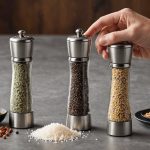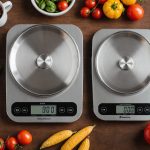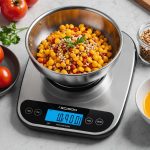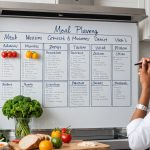Introduction to Precision Kitchen Scales
In the culinary realm, accuracy becomes paramount for consistent and delicious results. This is where precision kitchen scales shine, offering an edge over traditional scales. Unlike conventional kitchen measurement tools, precision scales provide exact measurements, essential for recipes requiring meticulousness, such as baking fluffy soufflés or delicate pastries.
Precision kitchen scales distinguish themselves by offering smaller measurement increments, often down to the gram, unlike traditional scales which may only measure in larger increments. This enhanced accuracy is critical in both cooking and baking, where the ratio of ingredients can significantly impact flavour and texture.
In parallel : Shine bright: the definitive guide to revitalizing your stainless steel gas cooktop
The benefits of utilizing a precision kitchen scale are manifold. In meal preparation, precision scales ensure correct portions, aiding in dietary adherence and portion control. For those passionate about cooking precision, these scales facilitate the exact replication of recipes, offering the promise of perfect results every time.
Moreover, the precision offered by these scales helps in reducing waste and ensuring ingredient efficiency—essential for both home cooks and master chefs alike. By adopting a precision kitchen scale, culinary enthusiasts can elevate their cooking experience, resulting in meals that meet the highest standards.
Also read : Space-savvy toaster ovens: ideal solutions for charming kitchens with limited counter room
Types of Precision Kitchen Scales
Two main types of kitchen scales are available: digital scales and mechanical scales. Each type has its distinct features catering to various user needs and preferences.
Digital Precision Scales
Digital scales are highly favoured for their advanced features, including precise measurement capabilities and ease of use. Digital scales typically offer a user-friendly interface, often featuring backlit displays for improved readability. They are ideal for tech-savvy users who prioritize convenience and accuracy in their culinary exploits. Among their notable advantages is the ability to convert units quickly, catering to diverse cooking precision requirements. However, digital scales rely on batteries, which need monitoring to ensure consistent performance.
Mechanical Precision Scales
Mechanical scales offer a more traditional approach, appealing to those who prefer simplicity and battery-free operation. These scales rely on a spring mechanism, providing durability and long service life. While mechanical scales might lack the exact precision of digital counterparts, they bring reliability and can withstand heavy kitchen use.
Portable and Compact Scales
For those frequently on the go or with limited kitchen space, portable and compact scales present a convenient solution. These scales combine the key attributes of portability and precision, perfect for travel or small kitchens. They suit users prioritizing convenience without sacrificing measurement accuracy.
Key Features to Consider
When selecting kitchen scale features, it’s crucial to consider weighing capacities and measurement increments. Opt for scales with a capacity that fits frequent cooking needs, yet capable of detailed measurements down to 1 gram for meticulous recipes. Such precision ensures accuracy whether baking a delicate sponge cake or portioning out spices for curries.
Readability is another key factor. Scales with backlit displays enhance visibility in dim kitchens, while the ability for unit conversions simplifies switching between grams and ounces. This feature is indispensable for international recipes, providing a smoother cooking experience.
Additional features can augment the usability of your kitchen scale. The tare function allows users to reset the scale to zero after placing a container, facilitating accurate ingredient measurement. Waterproofing can ensure longevity, particularly in a bustling kitchen environment, avoiding damage from spills. Battery life is also worth considering for digital scales, as a longer life reduces the need for replacements, ensuring consistent performance.
Incorporating these features can greatly enhance cooking precision. Weighing capacities, ease of readability, and additional functionalities like tare and waterproofing not only improve accuracy but also contribute to a seamless culinary process, transforming kitchen tasks into efficient and enjoyable experiences.
How to Use a Precision Kitchen Scale
Using kitchen scales effectively is crucial for achieving the desired cooking outcomes. Begin by ensuring the scale is on a flat surface, which provides a stable foundation for accurate readings. It’s advisable to use the tare function to reset the scale to zero once a bowl or container is placed on it. This action allows for measurement accuracy without the need to calculate the container’s weight manually.
While measuring, ensure the ingredient is centered on the scale for precise results. Common mistakes include overlooking the unit conversion feature, which is vital for adapting recipes from different measurement systems. Additionally, verify that the batteries are functional, as low power can result in inaccurate readings.
For accuracy maintenance, regularly clean the scale and handle it with care to avoid damage. Following these cooking tips ensures precise measurements, beneficial for recipes demanding meticulous proportions. These practices not only enhance the outcome of complex dishes but also aid in maintaining nutritional balance in meal preparations.
By integrating these strategies, chefs and home cooks alike can heighten their culinary precision, paving the way for consistent and impressive culinary achievements.
Comparisons of Top Precision Kitchen Scales
When exploring the best kitchen scales, understanding user experiences and performance metrics is crucial for making informed choices.
Comparison Chart of Leading Brands
Leading precision kitchen scales are often differentiated by their kitchen measurement tools and added features that cater to specific culinary needs. Brands like Ozeri, GreaterGoods, and Etekcity often top household and professional lists due to their high levels of cooking precision. They offer scales that vary in size, design, weight capacity, and diverse measurement functionalities.
User Review Highlights
User reviews frequently highlight the reliability, accuracy, and ease of use of various models. Ozeri scales are praised for their user-friendly interfaces and quick unit conversion capabilities, while GreaterGoods gets commendations for its sleek design and affordability. Etekcity often earns high marks for durability and precise readings, making them ideal for meticulous cooks and bakers.
Price vs. Performance Analysis
In the price-performance landscape, it’s important to weigh cost against longevity and features offered. Mid-range options like GreaterGoods deliver satisfactory precision at a reasonable cost, while premium brands might justify higher price tags with enhanced functions like waterproofing and extended battery life, appealing to users needing the highest standard of precision. Exploring the diverse options helps individuals find scales that meet specific needs without overshooting their budget.
Recommendations for Different Use Cases
When exploring kitchen scale recommendations, consider how different models cater to specific cooking scenarios. For home cooks, choosing the best scales for baking is crucial. Precision kitchen scales with features such as incremental measurements down to one gram can enhance recipe accuracy, especially for delicate confections like macarons or soufflés. Digital scales with tare functions are typically preferred by bakers for their convenience and precision.
In professional kitchen environments, cooking solutions demand reliable and durable scales. Greater weighing capacities and robustness are essential characteristics. Mechanical scales, though less precise, often withstand high-volume use, making them suitable for heavy-duty tasks.
Health-conscious individuals or those tracking dietary intake benefit from scales that offer easy unit conversions and nutritional data display. Models with smartphone compatibilities can provide comprehensive tracking and feedback, aiding in maintaining balanced diets.
Consider these kitchen measurement tools for versatile needs:
- Digital scales with memory function to store recipes.
- Compact scales for easy storage and portability.
- Stainless steel platforms, which are both durable and easy to clean.
Selecting the right scale from these kitchen scale recommendations ensures the fulfillment of specific culinary needs, whether in a home kitchen or professional setting, enhancing diet adherence, and supporting precise results.
Practical Applications of Precision Kitchen Scales
Incorporating precision kitchen scales into cooking routines can significantly enhance recipe accuracy and cooking precision. These kitchen measurement tools are especially crucial in recipes like macarons, soufflés, and artisanal bread, where precise ingredient ratios define success. Accurate measurements ensure consistent texture and taste, pivotal in both baking and cooking.
A precision scale also becomes invaluable in meal prep and nutrition tracking. Accurately portioned meals contribute to dietary adherence, helping individuals maintain desired nutritional goals. By using these scales to weigh ingredients before cooking, one can minimise waste, ensuring each component is used efficiently.
Cooking precision achieved through a scale also leads to replicable results. Preparing complex recipes becomes less daunting when you can trust the accuracy of your measurements. The precision offered by these scales can transform a novice cook into a master chef by delivering precision that might otherwise be difficult to achieve with traditional tools.
In addition to aiding in culinary tasks, scales can streamline meal planning. When portioning proteins or dividing recipes for storage, accurate scales help in creating equal portions, making meal planning both easier and more precise. This approach allows cooks to experiment confidently with new recipes, knowing their portions and ingredients are correctly measured.
Visual Guides and Charts
Understanding the practical use of precision kitchen scales is facilitated through visual aids. Kitchen scale visuals and measurement conversions are invaluable for both novice and experienced cooks, providing clarity and assistance during the cooking process.
Infographics on Measurement Conversions
Infographics effectively detail the transformation between different measurement units, essential for international recipes. A straightforward conversion table can illustrate how grams convert to ounces or milliliters to cups, streamlining the cooking process for users who frequently move between metric and imperial systems. Visual representation of these conversions eliminates confusion, ensuring accuracy and cooking precision.
Visuals of Scale Usage
Images demonstrating proper scale usage, from setting the tare function to correctly positioning ingredients, can assist in avoiding common mishaps. Graphics showing steps such as placing the bowl before zeroing the scale are crucial for accurate results, especially when dealing with incremental measurements.
Charts on Ingredient Weights
Ingredient charts portray typical weights of common items like flour, sugar, and butter. These visual guides help cooks estimate ingredient weights quickly, supporting efficient meal preparation. Paired with their scales, chefs can visually verify that their measurements align with known standards, enhancing consistency in recipes.
Including these tools in cooking guides can greatly augment the accessibility and utility of precision scales, emphasizing their role in delivering reliable and replicable results.











